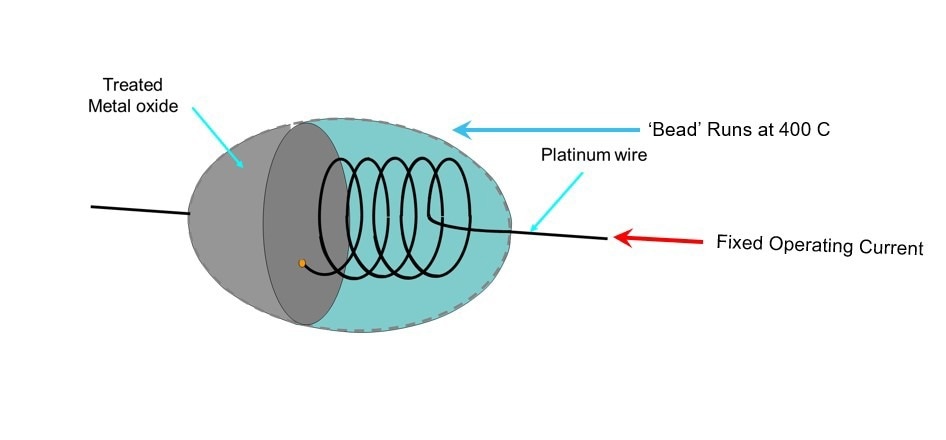In this interview, AZoSensors talks to Andrew Collier about MK8 Pellistors' features, applications, and benefits.
What is a pellistor and how is it used?
A pellistor, also known as a catalytic gas detector, detects flammable gases through combustion. Specifically, a pellistor constitutes a coil of platinum wire about the thickness of a human hair, or 4,000th of an inch diameter, coated with a catalyst material. A fixed operating current runs through this wire and is heated to about 400°C. Any present gas will combust on the bead's surface and change its temperature. If the temperature increases, the resistance of the platinum wire changes. This is Ohm's law, V over IR, so the change is directly proportional to the amount of flammable gas present.
In a practical device, there are two beads. One has an active catalyst, where gas will combust on its surface. The other is plated with a material of a similar mass but with no catalytic reaction. This one, known as a compensator, responds to room temperature change, and the active one responds to room temperature change and gas. The difference between them is the gas reading.

Image Credits: International Gas Detectors
What are some challenges or considerations when using a pellistor?
It is important for the pellistor to not act as a point of ignition. When built into a sensor, it is placed behind a metal filter that gas can permeate. The filter cools down any generated flame and prevents it from getting to the outside world. The practical device cannot combust the atmosphere around it but can measure the flammable gas loads.
Another challenge is that pellistors can suffer from poisoning, a contaminant that coats the surface. Most of these have phased out with Roche compliance and other legislation. However, silicons remain a problem. Propellants, such as hairsprays, furniture polishes, lubricants, etc, contain silicons and can coat the surface, preventing gas from accessing the active catalyst. Careful design of the catalyst and its substrate and how we control diffusion can result in a long-lasting device that is sensitive enough to be useful as a sensor and relatively immune to silicon poisoning.
How do you ensure your devices are safeguarded against poisoning?
Standard tests in the industry are geared toward exposing the sensor to a certain amount of poisoning compound and examining what happens to its sensitivity following exposure. We expose the sensors to around 20 times the industry standard level, which offers an edge over the competition.
Which applications are best suited for pellistor use?
This device has been used across the industry in every type of application for a long time. We always start with the question, "Does this application not suit a pellistor?" Other technologies, like infrared, have come along in the last 20 years and can be a good option. However, unlike a pellistor, infrared cannot sense all flammable gases.
Can you speak about situations that would not be a good fit for a pellistor?
There are potential conflicts, such as vibration. Heavier hydrocarbons, particularly solvents and vapors, may be an option. However, that is dependent on the flashpoint of the material. The flashpoint is the temperature where it develops enough surface vapor to become flammable. If the flashpoint is quite high, that can be quite difficult. For example, if the flashpoint is 40°C, it can be challenging to navigate. Heavier hydrocarbons, such as solvents, can deposit combustion products onto the sensor.
How does infrared technology compare to pellistors?
Infrareds have many more failure modes than a pellistor does and are less reliable. Generally, the market consensus is that the pellistor is extremely poison-resistant, which is beneficial in most applications and industries and of particular relevance to the emerging hydrogen economy.
There are few reliable technologies for gas detection for hydrogen leaks, with pellistors being at the forefront. Infrared detectors are unsuitable for optical monitoring. You can use semiconductors, but they tend to be very unreliable. Pellistors would be the detection method of choice.
What are the different types of gases the MK8 pellistor can detect?
A pellistor will detect any flammable gas or vapor. Each gas or vapor will have its own calorific value, so it will burn at a different temperature. Knowing which flammable gas you are looking for to calibrate the detector is essential. Hydrogen can be used as a calibration gas, so you can change the gain on the sensor, similar to changing the volume on speakers.
There are standard tables that help decipher precisely how the device will perform against different gases. This can be part of the decision about whether this is suited to the application.

Image Credit: Marek Polewski/Shutterstock.com
How has this technology changed over time?
The actual construction of the sensor itself has changed a lot, including the development of the sensor, the material used as catalysts, the construction, how the catalyst is employed inside a practical device, and how we are going to diffusion control limit gas to it.
We also now have microprocessors that allow us to sample close to a million times a second. This means a huge influx of possibilities in terms of the amount of processing power available directly on the sensor head. The sensor itself becomes intelligent. This means more machine learning and the ability to adapt and correct itself in the future. Microprocessors also significantly improve stability and enable contamination detection, lengthening the life of the device.
We also know the linearity of the sensor and the initial sensitivity, and we can store that on the detector head so that you can monitor sensitivity changes every time it is calibrated.
Can you explain the hydrogen economy and why it is an important concept?
Hydrogen has existed for a long time, but the world realizes it is a much cleaner fuel source than hydrocarbon-based economies. Most things currently contain a hydrogen-carbon bond, such as methane, propane, or gasoline. When burned as a fuel, they release carbon and increase CO2 levels. CO2 is an insulating gas, so the temperature rises on the planet. Water and heat are the only byproduct of burning hydrogen, making it a clean energy source.
There are ways to generate clean energy with wind farms or wave power, but storage problems arise. Batteries are impractical, but using that electricity to generate hydrogen allows the energy to be used when and where you need it, such as in commercial vehicles.
What are some practical uses of hydrogen?
Hydrogen is starting to emerge in municipal transport. There is a need for hydrogen gas detection in bus garages and repair stations where hydrogen is the fuel source. Hydrogen has replaced helium as the smallest molecule, making it more prone to leaking. Hydrogen will leak through the steel itself at a molecular level. The more pipe fittings, flanges, and valves in a process, the more likely a leak will occur.
The concern is that hydrogen is explosive over a wide range of atmospheric concentrations and at a very low ignition energy. Detection is going to become increasingly important moving forward.
How can the MK8 pellistor help in improving the hydrogen economy?
The MK8 pellistor produces a reliable, effective, and cost-effective method to detect and react to leaks. For many, hydrogen safety is of top concern, making leak detection paramount. Leaks are inevitable; the important thing is to have reliable technology that can detect them quickly and effectively and be able to shut down the process.
Regarding domestic applications, homes are becoming more sealed with advancements such as spray foam insulation and double-glazing. A gas leak in that environment can be hazardous. Using gas detectors domestically will become more relevant, particularly as we move into the hydrogen economy.
About Andrew Collier
Andrew Collier has been the Managing Director of the ‘Gas Detectors Ltd’ group of companies since 1996. Originally trained as a design engineer and working in a diverse range of companies encompassing power transmission, instrumentation, lens manufacturing, and mass spectrometry, Andrew joined the group in 1988.
In 2007, Andrew led the successful management buyout of the group from the existing owner, Mr Richard Oliver, and has continued to develop the company, its team, products, and services.

This information has been sourced, reviewed and adapted from materials provided by International Gas Detectors Ltd.
For more information on this source, please visit International Gas Detectors Ltd.
Disclaimer: The views expressed here are those of the interviewee and do not necessarily represent the views of AZoM.com Limited (T/A) AZoNetwork, the owner and operator of this website. This disclaimer forms part of the Terms and Conditions of use of this website.